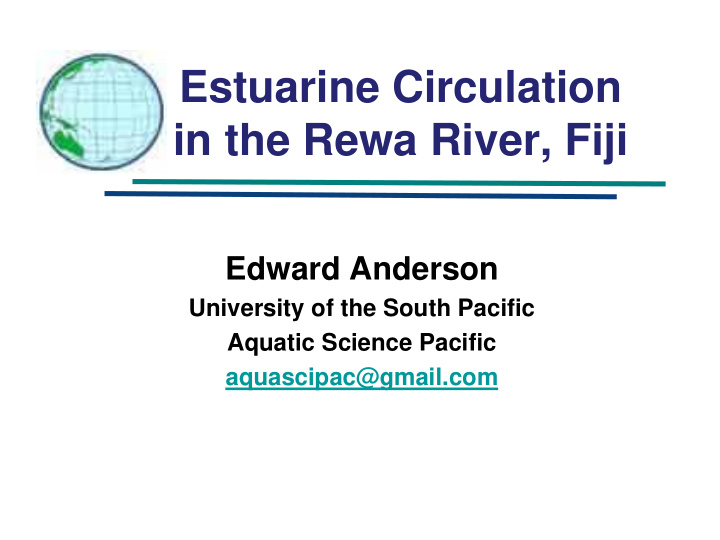



Estuarine Circulation in the Rewa River, Fiji Edward Anderson University of the South Pacific Aquatic Science Pacific aquascipac@gmail.com
Crew • We had an army of student ”volunteers” • From 2004 through 2010, we sampled the Rewa River in September or October. • There were about 20 to 60 each class
Boats • Halimeda is a 7.3 m vessel powered by two 150 hp outboard motors . • Hali can take about 15 students. • We took about 2 to 4 cruises per year
What are we trying to achieve? What kind of estuary is this? What is the effect of the recent dredging?
Schedule • We embarked at 0800n and returned at 1300 so that students could go to their next class • Organization, travel time and unloading time left only about 2hr to2.5hr on station. • We completed between 10 and 15 stations • We used CTD and droughes for each station
Estuarine types • Where river flow is strong, and tidal currents weak, salt- wedge type estuaries are favored • A partially mixed estuary where river flow and tidal mixing are about equal. Most estuaries are of this type. • Where tidal mixing is strong, and river flow weak, a well mixed estuary is favored.
Instruments • CTD measures salinity, temperature and depth • From salinity and temperature we get density, measured as sigma-t
The Rewa Sampling plan • The river is about 3m deep • It is deepest on the outside of the bends • There are deep holes upstream at Kalabo bend, near the Rewa bridge, and where the river makes a sharp turn to enter the sea • There are about 12 stations • All begin at the bridge • Some terminate in Laucala Bay, and some in the ocean
General results • Density is in red. • From upstream at Station the there is freshwater all the way to the bottom • There is a saltwater and shallow depth in the middle • Outside in Laucala Bay, there are traces of freshwater at the top, but almost uniform density below that
Results to date • We have continuous records river at the primary gauge at Navalou from 2009 forward, • From 2004 through 2008. project HYCOS (SOPEC/SPC) keeps these records • We prefer the transects which terminate in the sea. Only the 1 2009 and 2010 satisfy all criteria. • We present results which meet these criteria.
River flow has a dominante effect • Low Assembled Results 2008 and 2010 flow. 77.0 5 • High 77.05 2010-10-01 R2 flow, 255. 13 255.13 2010-10-08 R2
The others … 2008-10-26 R2 2008-10-03 R2 2008-09-26 R2
Assembled Results 2008 and 2010 77.05 2010-10-01 R2 255.13 2010-10-08 R2
What of the people of the Rewa Delta?
End
Recommend
More recommend